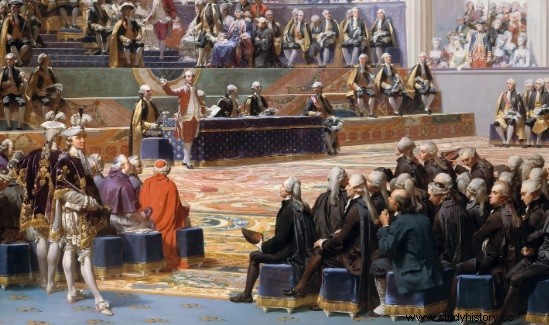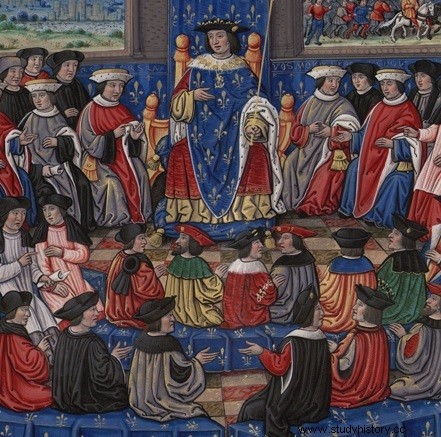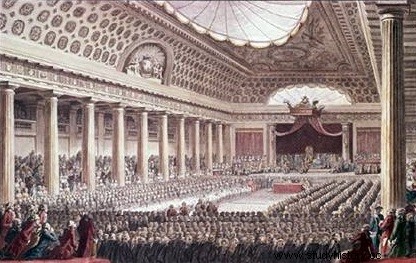 In France, the estates general were an assembly convened by the king from the Middle Ages to resolve political or financial crises. While the convocation of the representatives of the three orders (clergy, nobility and third estate) had not taken place since 1614, they met in 1789 by King Louis XVI to resolve the serious financial crisis that the kingdom is going through. They open on May 5, but each order meets separately without the central question of voting by head or by order having been decided. The Third Estate ended up declaring itself the Constituent National Assembly on June 17, thus ending the absolute monarchy in France.
In France, the estates general were an assembly convened by the king from the Middle Ages to resolve political or financial crises. While the convocation of the representatives of the three orders (clergy, nobility and third estate) had not taken place since 1614, they met in 1789 by King Louis XVI to resolve the serious financial crisis that the kingdom is going through. They open on May 5, but each order meets separately without the central question of voting by head or by order having been decided. The Third Estate ended up declaring itself the Constituent National Assembly on June 17, thus ending the absolute monarchy in France.
The Estates General under the Old Regime
In the France of the Ancien Régime, the Estates General designated the general assemblies of the nation organized both in orders and in countries. Sometimes the king consulted only the ecclesiastics and the nobles, sometimes like Saint Louis in 1263 about laws on the currency, the bourgeois of the cities. Unlike the English parliamentary system, the French Estates-General therefore derived solely from royal initiative. This is why they had no regular periodicity:the king thought of summoning them only at critical moments.
 There have been twenty-eight consultations of the States General since those of 1302, convened by Philippe le Bel (who obtained their support in its quarrel with Pope Boniface VIII), until those of 1614, convened by Marie de Medici, who discredited the institution as the dissensions between the three orders were great. The most important were:those of October 1356 and February 1357 which opposed a severe control of power in exchange for exceptional taxes requested by the Dauphin Charles (future Charles V), who finally dismissed them; those of 1484, which conceded the regency to Anne of France, after the death of Louis XI.
There have been twenty-eight consultations of the States General since those of 1302, convened by Philippe le Bel (who obtained their support in its quarrel with Pope Boniface VIII), until those of 1614, convened by Marie de Medici, who discredited the institution as the dissensions between the three orders were great. The most important were:those of October 1356 and February 1357 which opposed a severe control of power in exchange for exceptional taxes requested by the Dauphin Charles (future Charles V), who finally dismissed them; those of 1484, which conceded the regency to Anne of France, after the death of Louis XI.
The convocation of the Estates General of 1789
In 1788, the impossibility for the French monarchy to remedy the disastrous state of finances suggests that the only solution lies in the meeting of the States General. In the month of July, the parliament, rejecting the “territorial subsidy” which would have hit the privileged like all other landowners, declared that only the nation united in its states-general could consent to a perpetual tax.
This appeal to the states therefore crystallized the wishes of all opponents. The government first considered the convocation of the states for 1792, but the financial and political crisis worsening rapidly, Brienne had it decided, on August 8, 1788, that the states general would be convoked for May 1, 1789.
The different orders and the third estate
The privileged orders, in principle hostile to any reform likely to call into question their achievements and their predominance, see this as an opportunity to sustainably consolidate the essential foundations of society. The nobility, represented by 270 deputies, wants the end of the absolute monarchy, in place since Louis XIV, in order to regain its former rights. The clergy, strong with its 291 deputies, also derives great benefit, in particular through the collection of the tithe among other things, wishes the maintenance of the current institutions.
578 deputies formed the Tiers at the Estates General of May 5, 1789. The Tiers was made up of the bourgeoisie and the peasantry. The bourgeoisie, rather urban and enriched by trade and finance, sensitive to the new ideas of the Enlightenment, saw its economic strength and its claims blocked by its commoner origins:only the nobles had access to the posts of officers or to high positions in the state, while being exempt from taxes and duties. As for the peasantry, overwhelmed by the fiscal burden of taxes and subject to scarcity due to the poor harvests of recent years, they opposed the tax system and the behavior of farmers general and intendants accused of corruption. It demands guarantees for individual freedoms.
The election of representatives took place in January 1789. The representatives of the Tiers were designated indirectly:only men over twenty-five and who paid tax have the right to vote.
What type of ballot in the Estates General?
By deciding to convene the Estates General, the King leaves two questions unanswered:will the representation of the Third Estate be proportional to its place in the nation or equal to that of the clergy? ? Will we vote by orders or by heads? If we keep the forms of 1614, the privileged can only prevail. On the contrary, if we grant the Third Party a representation corresponding to its importance, and where we would vote by heads, it is he who would be able to impose his will.
This debate leads to the rupture between the Third Party and the privileged. The clergy and the nobility want the vote to take place by orders, which assures them of the majority against the Third Estate. The latter calls for a vote by head, in order to obtain equality in the debates.
The opening of the Estates General
 Presided over by the king himself, the first session took place on May 5, 1789 in the Salle des Menus- Pleasures at Versailles. Facing Louis XVI are the representatives of the third estate (with as many deputies as the two other orders combined). On the king's left, the representatives of the nobility and, on his right, those of the clergy.
Presided over by the king himself, the first session took place on May 5, 1789 in the Salle des Menus- Pleasures at Versailles. Facing Louis XVI are the representatives of the third estate (with as many deputies as the two other orders combined). On the king's left, the representatives of the nobility and, on his right, those of the clergy.
In a meaningless speech, Louis XVI warned deputies against any innovation, saying that he "knew his authority and would maintain it" and that he "enjoyed in advance of the consoling hope of seeing serene and tranquil days succeed days of storm and anxiety".
The attitude turns out to be contemptuous towards the Third Party. By imposing a very specific dress code for each order, namely a black suit for the third party, a black coat with gold facings and feathered hat for the nobility, and the ceremonial ecclesiastical costume for the clergy. Louis XVI expressed his desire to maintain the distinction between the three orders. The king supports voting by order.
The proclamation of the National Assembly
On June 17, the Tiers invites the deputies of the two other orders to join it. Some liberal nobles and clerics close to the people join him. The group thus constituted proclaims itself “National Assembly”. Faced with this first revolutionary act, Louis XVI decided to assert his authority and had the Salle des Etats closed. On June 20, 1789, the deputies of the new National Assembly found another meeting place in Versailles, a tennis court. They promise not to separate until they have drafted a constitution for the country.
The National Constituent Assembly thus sat until September 30, 1791. It gave way to the Legislative Assembly or Constitution of 1791, which made France a constitutional monarchy. During the royal session of June 23, 1789, Bailly, dean of the Tiers, received the king's order to disperse the Assembly, which led Mirabeau to declare:"We are here by the will of the people and we do not only get out by force of bayonets. On June 24, the majority of the clergy joined the Tiers. Three days later, the king, having no other choice, invites the last refractories to sit in the Assembly.
A bourgeois and peaceful revolution has just taken place. The National Assembly exercises control over public finances and guarantees the nation's individual freedoms. From now on, absolute monarchy no longer exists in France.
